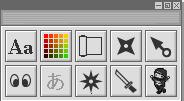 |
|
× [PR]上記の広告は3ヶ月以上新規記事投稿のないブログに表示されています。新しい記事を書く事で広告が消えます。 |
 |
 |
|
The Japanese armor was only worn by the shogun, highest military class, samurai and emperors. The samurai armor over the centuries was incredibly varied yet throughout the samurai age the principles of the armor remained largely the same, except for a few minor changes.It consisted of a kabuto (helmet) for the head; a do; a pair of sode (shoulder guards); one or two kote (armoured sleeves) for the arms; a kusazuri (armoured skirt or apron) to protect the upper thighs; and a pair of suneate (shin guards.) Haidate (thigh guards) were added in around the 14th century and by the 16th, the mempo (face mask) was introduced.
The first prototype for Japanese samurai armor came about in the form of the yoroi during the Gempei War of 1181-1185. Each piece of armor consisted of a set of small iron plates called kozane laced together by leather cord. The resultant strips were then lacquered to protect the material against rust and then a series were tied together horizontally with silk cords called kebiki-odoshi to produce a light and fairly resilient armor plate. The ‘Do’ was the name of the upper-body armor of the samurai. This comprised of the ‘Sode’, the suspended shoulder and upper-arm protection plates. The Sode had hoops by which silk cord was tied and then fixed to the back of the armor in an ‘agemaki’ / decorative knotted tassel. Guards were also placed over the shoulder cords, and a leather plate placed across the bow cords to prevent them from been cut or becoming ensnared during a skirmish. Samurais had protective helmet, known as kabuto. It was formed of eight to a dozen plates all fixed together with cone shaped bolts. In the eleventh century the type of helmet Hoshi Kabuto were characterized by large, high standing, rivet heads. Also, as many samurai had long hair, in the centre of the helmet’s crown was made a gap for the ponytail. Like in many other cultures, a samurai’s helmet had not only a protective role, but it was also meant to show the samurai’s rank, and that is why the kabuto was often be very elaborate and decorative looking. The kabuto with its characteristic fukigaeshi (winglets or turnbacks) at the front of the shikoro (neck guard) and the kuwagata (twin horned crest) above the helmet’s peak gave the samurai its enduring and appealing image. Shikoro is the name of the thick five-plated protector of the back of the head, neck and the cheekbone which was fastened to the bowl of the helmet. The top four plates of the Shikoro would be upturned to create the fukigaeshi. The fukigaeshi are useful in the prevention of the vertical slicing of the shikoro’s horizontal fastening chords. A visor is also on the front of helmet and is known as the mabisashi. the mabisashi is not only meant to protect the samurai from the light of the sun, but to also protect him from the extended and downward strike of the enemy’s sword.A silk cap-like headgear was worn under the helmet. Up to the 14th century the o-yoroi or ‘great armour’ was standard for the samurai. Its box-like appearance, large square sode, and equally large kusazuri was ideal for mounted warfare. As the samurai during this early time of the Gempei War fought much on horseback and utilized bows and arrows, the right arm of the standard samurai soldier had no restricting protection to allow for the drawing back of the bow. A light protective sleeve was worn on the left arm. Not all fighters during the Gempei War were of the samurai class, and therefore were equipped differently and wore a different style of lighter armor called the ‘Do Maru’ By about the 14th century warfare in Japan was changing. Samurai were more and more fighting on foot and campaigns were becoming more protracted and lengthy. the samurai armor needed important changes because the traditional o-yoroi was getting too heavy for this. As a result the proud samurai has chosen to wear do-maru (literally ‘torso round’) as well as it was lighter and easier for the wearer to move and fight in. PR |
 |
|
COMMENT:
|
|
COMMENT EDIT :
|
|
|
|
忍者ブログ [PR] |



